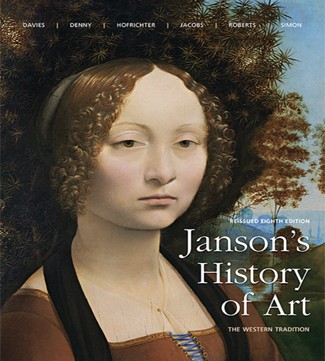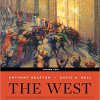Test bank for Janson’s History of Art 8th Edition Davies Denny Hofrichter Jacobs Roberts Simon
$35.00 Original price was: $35.00.$26.50Current price is: $26.50.
Test bank for Janson’s History of Art 8th Edition Davies Denny Hofrichter Jacobs Roberts Simon
This is completed downloadable of Test bank for Janson’s History of Art 8th Edition Davies Denny Hofrichter Jacobs Roberts Simon

Product Details:
- ISBN-10 : 0133878295
- ISBN-13 : 978-0133878295
- Author: Penelope J.E. Davies (Author), Frima Fox Hofrichter (Author), Joseph F. Jacobs (Author), David L. Simon (Author), Ann S. Roberts (Author), Family Trust Janson (Author)
Janson’s History of Art: The Western Tradition, Reissued Eighth Edition presents the same content as the text’s Eighth Edition, published in 2010, now reimagined for digital learning via Revel, and also available through the Pearson Custom Library. While remaining current with new discoveries and scholarship, the Reissued Eighth Edition maintains its focus on the object, its manufacture, and its visual character, and continues to consider the contribution of the artist as a key element of analysis. Throughout, the authors engage students by weaving a compelling narrative of how art has changed over time in the cultures that Europe has claimed as its heritage.
Janson’s History of Art: The Western Tradition, Reissued Eighth Edition is also available via Revel™, an immersive learning experience designed for the way today’s students read, think, and learn.
For enrollments of at least 25, the Pearson Custom Library allows you to create your own textbook by combining chapters from best-selling Pearson textbooks and by adding your own content, such as a guide to a local art museum, a map of monuments in your area, your syllabus, or a study guide you’ve created. Priced according to the number of chapters, a custom text may even save your students money.
Table of Content:
CHAPTER 1: PREHISTORIC ART 3
CHAPTER 2: ANCIENT NEAR EASTERN ART 6
CHAPTER 3: EGYPTIAN ART 9
CHAPTER 4: AEGEAN ART 12
CHAPTER 5: GREEK ART 15
CHAPTER 6: ETRUSCAN ART 18
CHAPTER 7: ROMAN ART 21
CHAPTER 8: EARLY CHRISTIAN AND BYZANTINE ART 24
CHAPTER 9: ISLAMIC ART 27
CHAPTER 10: EARLY MEDIEVAL ART 30
CHAPTER 11: ROMANESQUE ART 33
CHAPTER 12: GOTHIC ART 36
CHAPTER 13: ART IN THIRTEENTH- AND FOURTEENTH-CENTURY ITALY 39
CHAPTER 14: ARTISTIC INNOVATIONS IN FIFTEENTH-CENTURY
NORTHERN EUROPE 42
CHAPTER 15: THE EARLY RENAISSANCE IN FIFTEENTH-CENTURY ITALY 45
CHAPTER 16: THE HIGH RENAISSANCE IN ITALY, 1495–1520 48
CHAPTER 17: THE LATE RENAISSANCE AND MANNERISM IN SIXTEENTH-
CENTURY ITALY 51
CHAPTER 18: RENAISSANCE AND REFORMATION IN SIXTEENTH-CENTURY
NORTHERN EUROPE 54
CHAPTER 19: THE BAROQUE IN ITALY AND SPAIN 57
CHAPTER 20: THE BAROQUE IN THE NETHERLANDS 60
CHAPTER 21: THE BAROQUE IN FRANCE AND ENGLAND 63
CHAPTER 22: THE ROCOCO 66
CHAPTER 23: ART IN THE AGE OF THE ENLIGHTENMENT, 1750–1789 69
CHAPTER 24: ART IN THE AGE OF ROMANTICISM, 1789–1848 72
CHAPTER 25: THE AGE OF POSITIVISM: REALISM, IMPRESSIONISM, AND
THE PRE-RAPHAELITES, 1848–1885 75
CHAPTER 26: PROGRESS AND ITS DISCONTENTS: POST-IMPRESSIONISM,
SYMBOLISM, AND ART NOUVEAU, 1880–1905 78
CHAPTER 27: TOWARD ABSTRACTION: THE MODERNIST REVOLUTION,
1904–1914 81
CHAPTER 28: ART BETWEEN THE WARS 84
CHAPTER 29: POSTWAR TO POSTMODERN, 1945–1980 87
CHAPTER 30: THE POSTMODERN ERA: ART SINCE 1980 90
MULTIPLE CHOICE
Chapter 1 (Prehistoric Art)
1. Paleolithic cave paintings, such as those found in the Hall of the Bulls (1.8), are characterized by _______.
a. an abundance of abstract images
b. images of humans
c. scenes of birth
d. images of animals
Answer: d. (pp. 5-6)
2. In comparing the Woman from Brassempouy (1.13) to the Woman from Willendorf (1.14), the function of both is most probably ___________.
a. a decorative element in a larger sculptural work
b. a fertility object
c. unknown
d. as a model for the artist
Answer: b. (p. 10)
3. In comparison to the Paleolithic Hall of Bulls (1.8), the Neolithic View of Town and Volcano (1.20) from Çatal Hüyük depicts __________.
a. multiple animal figures in a scene from a hunt
b. a religious ritual
c. a landscape
d. multiple human figures engaged in scenes from daily life
Answer: c. (p. 14)
4. The earliest cave paintings at Chauvet date to the ___________ period.
a. Mesolithic
b. Paleolithic
c. Neolithic
d. Jurassic
Answer: b. (p. 2)
5. According to the text, the images in the Overlapping animal engravings (1.7) might record ________.
a. migrations
b. shamanism
c. daily life
d. the hunt
Answer: a. (p. 6)
6. One interpretation of Rhinoceros, Wounded Man, and Bison (1.4) is that it is a _______.
a. scene painted by women
b. narrative
c. migration scene
d. shaman’s vision
Answer: b. (p. 6)
7. A relative date indicates that an object is ________than another.
a. older
b. larger
c. older or more recent
d. smaller
Answer: c. (p. 17)
8. Megaliths arranged in circles are known as _______.
a. cromlechs
b. trilithic
c. dolmens
d. menhirs
Answer: a. (p. 16)
9. In contrasting the contexts of the Hall of Bulls (1.8) to the stick man at the same site, which of the following statements is most true?
a. Both were equally accessible.
b. Both were equally inaccessible.
c. The stick man was more accessible than the location of the Hall of the Bulls.
d. The Hall of the Bulls was more accessible than the location of the stick man.
Answer: d. (p. 6)
10. Two Bison (1.12) is a good example of ___________.
a. painting
b. relief sculpture
c. sculpture in the round
d. megalithic architecture
Answer: b. (p. 9)
11. The bulls’ horns in the scene of the Animal Hunt (1.21) from Çatal Hüyük were probably associated with ______.
a. solar symbolism
b. earth worship
c. shamanism
d. fertility
Answer: d. (p. 14)
12. Post-and-lintel architecture refers to _________.
a. a vertical stone
b. two upright stones supporting a third horizontal capstone
c. huge blocks of stone
d. a dolmen tomb
Answer: b. (p. 16)
13. The Female and male figures (1.22) from Cernavoda, Romania were found in a ________.
a. henge
b. house
c. tomb
d. cave
Answer: c. (p. 15)
14. The cave paintings at Altamira were originally considered a _____________.
a. religious site
b. great find
c. mystery
d. hoax
Answer: d. (p. 4)
15. The presence of a small hole between the front legs of the Horse (1.10) from Vogelherd Cave suggests that it was a _______.
a. relief sculpture
b. grave good
c. pendant
d. religious object
Answer: c. (p. 8)
People Also Search:
janson history of art 8th edition
janson’s history of art reissued 8th edition
janson’s history of art 8th edition pdf
Related products
Test Bank
Test Bank for Essentials of Business Law and the Legal Environment, 11th Edition: Richard A. Mann











